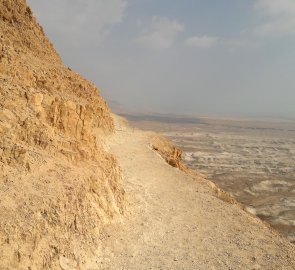Ascent of Masada Fortress at the Dead Sea in Israel
Mountain range, region / State
/ Israel
Season
Fall
24. 09. 2017
Difficulty
1 / 5
Elevation
↑ 662 m
↓ 661 m
Length
6.2 km
3 hours
Altitude
max. 50 m n.m.
min. -302 m n.m.
Trek to Masada Fortress Snake Path - in the footsteps of the 10th Roman Legion Fretensis
Starting point
The trek begins at the entrance to the main part of Masada Park, facing away from the Dead Sea in the eastern part of the Judean Desert. The path itself is called the Snake path. The second, easier path follows the embankment built by the Romans during the siege - Roman path (about 15 min). We tried both.
Description of the hike
The Masada Snake Path Trek is one of the most famous hiking trips in Israel. Starting from the base of Masada, the famous fortress that stands by the Dead Sea, the Snake Path runs about 400 vertical meters (photo) from the Dead Sea, the lowest point on earth (it has an altitude of -430 m above sea level) to the summit with the Masada fortress. Here, archaeological findings tell the story of the heroism and endurance of the Jewish warriors.
From the top one has a magnificent view of the Dead Sea and the Moab Mountains in the Jordan on the other side. We start our ascent to the fortress at the parking lot (photo) below the fortress and follow the marked path to the top. The path climbs gently in many switchbacks up to the fortress. The trail is wide and safe. After visiting the fort we try the Roman road. Then we return the same way.
Difficulty
The Snake path is a winding paved road up to Masada Fortress. I recommend not to underestimate the water supply, because the whole way is in direct sunlight and there is nowhere to hide. The exception would be if you go up at sunrise. There is a cable car station next to the Snake Trail gate at the starting point that will take more comfortable hikers to Masada Fort.
The Roman path is a perpendicular path from the car park directly to the fortress, following an artificial embankment left over from the siege by the Roman 10th Legion. The path is, in my opinion, manageable even by an untrained person.
Water availability
Water can be purchased at the restaurant in the parking lot of the trek's starting point. There is then a chilled drinking fountain at the top of the fort. Taking about 1.5 litres of water/person was enough for this trek.
Sleeping options
Accommodation in hostels/hotels in Arad or Ein Bokek.
Mountain peaks
Masada Fortress is located on a secluded rock. That is why it has amazing views. Especially the Dead Sea and the Moab Mountains in Jordan.
Danger
The only danger is the extreme heat in the area and the associated dehydration. It is therefore recommended to start the ascent of the fortress before sunrise.
Food
Restaurant at the entrance down below the fort. A snack of a banana and an apple was enough for us.
Attractions
The fortress of Masada was built by King Herod in the desert without human habitation, on top of a steep rock measuring about 650 by 300 metres. The complex includes tanks for 40,000 litres of water. After Herod's death and the annexation of Judea by Rome, a Roman garrison was stationed at Masada until the beginning of the Jewish revolt. At the very beginning of the revolt, a band of Zealots cunningly seized Masada, slaughtered the Roman garrison, and made the fortress their base for attacking the surrounding area. Therefore, the 10th Fretensis Legion under the command of Flavius Silva, together with auxiliary troops and several thousand prisoners, approached the fortress. The soldiers surrounded the entire fortress with a wall with watchtowers and spread out around it in eight fortified camps, the foundations of which can still be seen today. Access roads within range of the defenders were covered, and the head of the embankment was protected by an assault tower against which the defenders had no weapons. The day before the Romans entered the fortress, the Zealots decided that it was better to die at the hands of their fellows than to submit.
The men first hid the scrolls, which are now part of the Dead Sea Scrolls, then killed the women and children. Then they drew ten men from among themselves and had them killed. From the remaining ten they again drew one, who killed the others and then committed suicide himself (thus he was the only sinner - suicide). Today, Masada is the destination of many pilgrims and the site of a solemn oath by Israeli soldiers who declare, "Masada must not fall again."

